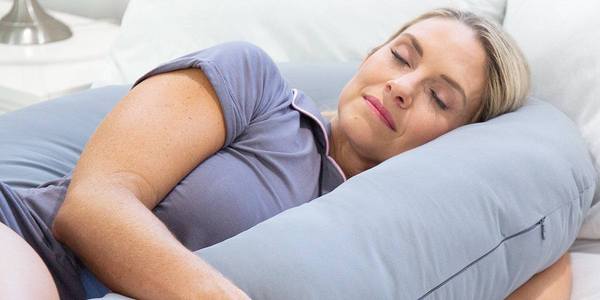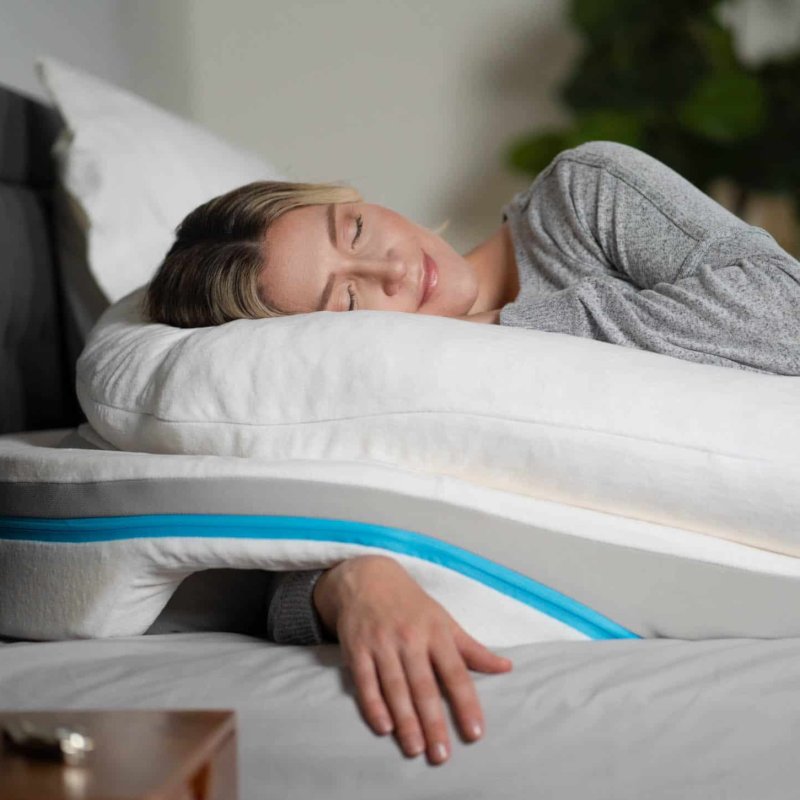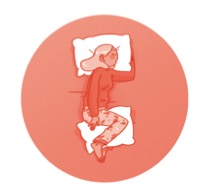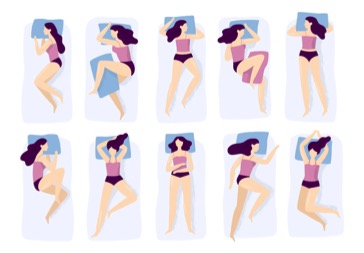BACK PAIN TREATMENT
The worst thing about being injured, is figuring out how to sleep to alleviate your pain and not make it worse. While that is annoying, it is worse when the pain is in the back. Back injuries eliminate a number of possible sleeping positions, causing extra frustration and anxiety which might worsen the pain instead of improving it. However, there are some staple back pain sleeping positions, mattress and pillow tips that will guarantee a tranquil and deep sleep.

THE OPTIMAL SLEEPING POSITIONS FOR BACK PAIN
1. Side sleep
When experiencing back pain in general or one-sided back pain, side sleeping comes in handy. There are two types of side sleep positions that one can use when experiencing back pain:
Sleeping on the side with a pillow placed in between the knees:-
- If sleeping on your back feels too painful and uncomfortable, laying on your side might make you feel better:
- Make sure that the shoulder and the whole left or right side of the body is in full contact with the mattress.
- Place a half firm pillow in between your knees to help keep your knees aligned and avoid having your back and hips constantly twist during the night.
- In the case where there is a cavity between the waist and the mattress, consider filling it with an additional small pillow for further support.
Whether you use one pillow or two, fight the tendency to sleep on the same side every night. Overdoing it can lead to muscle imbalance or further back complications such as scoliosis.
If you are asking yourself how this position is helpful for sleeping with back ache, here’s your answer: placing a pillow in between your knees while you sleep will allow your hips, pelvis, and spine to stay aligned all night. However, note that sleeping on your side alone will not alleviate your pain, the pillow in between your knees is the magic trick.
Sleeping on the side in a fetal position:-
- This is an ideal position to use in case the injury is a herniated disk. Here are some tips for sleeping in this curled fetal position:
- To get into the right position, lay on your back first then slowly and gently move onto the side position.
- Bend your torso towards your knees and then tuck your knees further to meet your chest.
- Just a reminder, to avoid any muscle imbalance or further complications, constantly switch from side to side.
The reason why this position is so helpful is because, in the case of a herniated disk, it is the fetal position that will allow your vertebras to loosen up. If you are wondering what the correlation between your vertebras and a herniated disk is, it is that this condition involves the discs, which are soft cushions between the vertebras, of your spine that have been dislocated out of its original space. That dislocation causes nerve pain and weakness in the back. So, opening up the space between the vertebras by rounding your back will take the edge off the pain.
2. Back sleep
While it might be controversial to sleep on your back when experiencing back pain, for some people it is actually the best sleeping position to alleviate any sort of back pain. There are two positions that people tend to turn to when deciding to sleep on their backs. These positions are:
Sleeping on your back with elevated knees
- Make sure that you are completely flat. You can use a pillow that ensures that your spine is well aligned or can use no pillow at all.
- Place a pillow below your knees and maintain a neutral spine. The cushion is crucial because it helps to maintain the natural curve in your lower back.
- For further support, fold up a small towel and lay it under the small of your back.
The reason why this position is so popular and helpful is that when sleeping on your back, the weight is evenly balanced and redistributed across the widest area of your body. As a result, the pressure points are less stressed. Furthermore, your spine and internal organs have a better alignment which adds to assuring one has a deep and non-painful sleep
Sleeping on your back in a reclined position
Do you feel better when you are sleeping in a recliner? That is no coincidence. A reclined position can be very beneficial for people who have injured their back especially those who have Isthmic spondylolisthesis, which is a lumbar spinal condition. This spinal condition involves having a vertebra slip over the one under it. The reason why sleeping in a reclined condition is beneficial, is because the 90-degree angle that is created between thighs and torso relieves any additional pressure from the spine.
3. Stomach sleep
In some cases, sleeping on your stomach might add additional stress on your neck and back, if you do feel comfortable on your stomach and it helps reduce your pain then let it be.
- To reduce some of the pressure on your back, place a pillow beneath your pelvis and lower abdomen.
- You may or may not want to place a pillow under your head, depending on how you feel in this posture.
Stomach sleeping with a pillow may be especially beneficial for people with degenerative disc condition. It might help to ease any strain on the space between your discs.

ADDITIONAL TIPS TO SLEEPING ON YOUR STOMACH
It is known that sleeping on your stomach actually causes more harm than good and is tough on one’s neck and back. This can result in restless nights and discomfort throughout the day. If you’re pregnant, pay special attention to your sleeping position and avoid sleeping on your stomach if at all possible. However, in the case where you cannot give up your favorite sleeping position, here are some additional tips to prevent any neck and back strain:
The flatter the pillow the better. Try keeping your back as flat as possible and in a neutral position. Stretch first thing in the morning
Sleep with a thin pillow or, if possible, no pillow at all. The reason for this is because the absence of that height will reduce the potential pressure on the neck and back This is mostly for the case where you are using a pillow, adding one under your pelvis with take any extra pressure off of your spine. Stretching for a few minutes will help you re-align your body and lightly strengthen back as well as any surrounding muscles. Always warm up with some light movement before stretching, or doing any sort of yoga flow, Pilates (hard exercising is not recommended with any back injury).
WHY IS ALIGNMENT SO IMPORTANT?
It is important to note that in the equation of alleviating your back pain, proper spine alignment is the most important component. Focus on aligning your spine from your ears, to your shoulders and all the way down to your hips.
In some cases, you may find yourself with gaps between your back and the bed. Those gaps must be filled pillows or towels to avoid straining the spine and back muscles.
It is also vital to be cautious if you are one to tumble in your sleep. Twisting and turning motions may cause you to lose alignment. Always try and move the entire body at the same time, pulling your core tight and in. As you turn over, you might find it useful to raise your knees closer to your chest.

DOES MY PILLOW MATTER
The ideal pillow is the one that can be adjustable to the position that one has decided to sleep in, while still maintaining its overall shape. It is important to ensure that you have picked the right pillow for you, as its role is to support the spine, ensure a popper alignment and preserve the neck’s natural position.
Thinner pillows are epitome of comfortable pillows for people who would prefer to sleep on their backs as they do not raise one’s head too much, preventing them from straining their necks and back muscles. It is also the perfect pillow to place under the hips for people who tend to sleep on their stomachs.
Thicker pillows however, are ideal for people who sleep on their sides. They help make sure that the space between the neck and mattress are completely filled.

DOES MY MATTRESS MATTER?
Finding the right mattress is as important as finding the right pillow. The right mattress is one that is supportive but yet comfortable. There are many factors that come into play when deciding on the right mattress. One of the factors are body shape. For people with wider hips, a softer mattress is recommended while people with narrow hips are better off with firmer mattress as it provides better support for spine alignment.
To debunk the myth, softer mattresses are actually not better for the back. They provide less support as they cause you to sink into the mattress which will affect the joint, twist it, and hurt the spine.
With that being said, it has been proven that the ultimate mattress is a medium-firm one that will, in the long run, improve sleep patterns.
OUTLOOK
All in all, there are many factors that injured people tend to worry about when injuring their backs, and sleep is a major one. However, picking the right sleep position for you and experimenting with all of them is crucial and essential to speeding your recovery up. Test different pillows and mattresses and consult any professional to make sure that you are picking one that is not worsening your condition but making them better.
If you or anyone you know is suffering from pain, call us today at (469) 545-9983.
